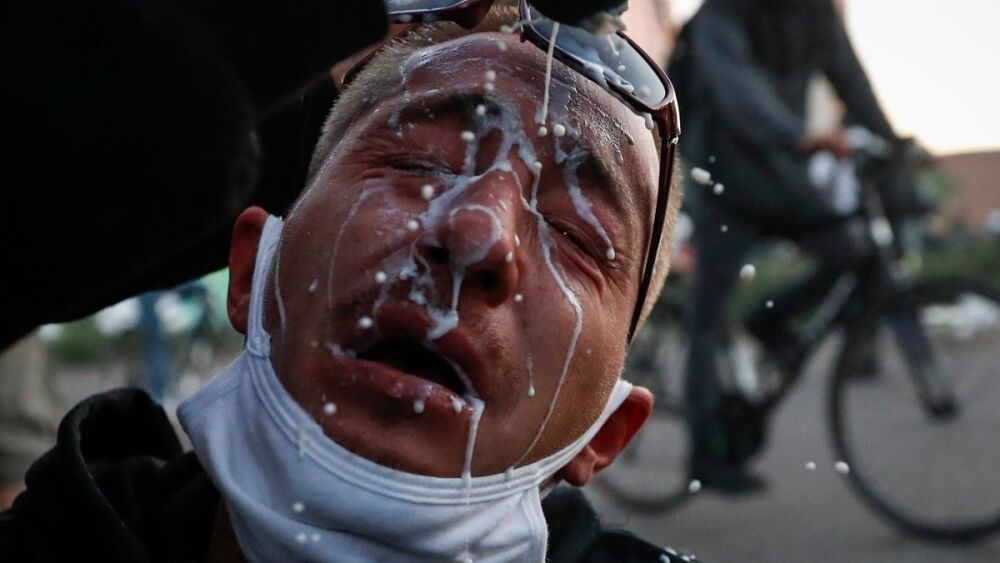Protests have the potential to turn into riots, resulting in blocked streets, looting, fires, violence and property damage, as we witnessed in Ferguson, Missouri, in 2014, and across the county after the death of George Floyd on May 25, 2020.
Law enforcement crowd control tactics include riot control agents (e.g., tear gas, pepper spray) and impact munitions (i.e., rubber bullets). Our law enforcement colleagues refer to these less-lethal agents as chemical munitions.
Here we’ll address the types of injuries EMS providers might encounter at protests, how to assess and treat tear gas injuries and those caused by rubber bullets, potential complications, and which patients require transport. Download a copy of this checklist to keep with you for a quick refresher.
Tear gas and pepper spray
Tear gas is used for riot control and to disperse crowds. It is composed of chemical irritants such as chloroacetophenone and chlorobenzylidene malononitrile. These agents work by binding to various ion channels found in nociceptors, which are responsible for sensing pain.
Pepper spray is composed of the active ingredients in hot peppers, such as oleoresin capsicum and capsaicin II. These agents target TRPV1, an ion channel in the nociceptors which are responsible for pain sensation.
Tear gas and pepper spray exposure symptoms
Tear gas and pepper spray cause skin, eye, respiratory and mucosal irritation.
Stinging and burning sensation, sneezing, coughing, headache, dizziness, tachycardia, difficulty breathing and rhinorrhea are the most common symptoms. Additionally, contaminated saliva that is swallowed can lead to epigastric discomfort, nausea and vomiting. Be aware that first-time exposure may cause panic and agitation.
A more in-depth review of tear gas and pepper spray symptoms include:
- Respiratory. Wheezing, rales, cough, dyspnea and hypoxemia. Patients with underlying conditions (e.g., asthma or emphysema) may develop more severe symptoms, such as respiratory distress or an allergic respiratory response.
- Skin. Erythema, blistering, rash and superficial burns. More serious burns are possible if patients have contact with the metal canisters used to disperse the gas.
- Eyes. Pain, conjunctivitis, photophobia, periorbital edema and eyelid erythema. More serious and long-term injuries can occur, such as uveitis, glaucoma, optic neuropathy and cataracts.
- Gastrointestinal. Nausea and vomiting are more common in situations where there is a long duration of exposure or high concentration of irritant. GI decontamination with activated charcoal or gastric lavage is not recommended because symptoms usually resolve spontaneously.
Treatment for suspected tear gas or pepper spray exposure
The mainstay of tear gas and pepper spray treatment is removal of the contaminating agent and supportive treatment. As always, ABCs come first. Protect and maintain the airway, using oxygen and PPV as needed. Regarding intubation, there are no contraindications to using succinylcholine or other depolarizing paralytics.
After ensuring your patient has a patent airway, remove any contaminated clothing and anything else that may be irritating the skin, eyes or mouth. Flush eyes with water or saline for 15-20 minutes and skin with water, soapy water or saline.
A small study published in the “Journal of Prehospital Emergency Care” found that there was no difference in pain when using milk, baby shampoo, water or Maalox – reported home remedies – after participants had been exposed to pepper spray [1]. However, due to the risk of infection from milk, water is recommended for flushing eyes.
When to transport patients exposed to tear gas/pepper spray
Should EMS transport patients exposed to tear gas or pepper spray?
It depends on the injury; the majority of patients will have no lasting long-term effects and irrigation will help with pain. That being said, more severe burns and respiratory distress are possible. Typically, symptoms should begin to subside once the irritant is removed. if patients don’t improve or continue to deteriorate once the exposure is eliminated, they should receive higher care.
Rubber bullets
Rubber bullets or pellets are less-lethal munitions designed to incapacitate individuals without inflicting serious injury. Some weapons may only fire one projectile, while others may spray multiple pellets, similar to a shotgun blast. They are designed to impact a larger surface area to disperse force on impact.
Injuries caused by rubber bullets
Although designed not to injure protestors, there can be a wide range of injuries when rubber bullets are involved. Less severe injuries include bruising and superficial lacerations, while more severe injuries include limb fractures, skull fractures, epidural hemorrhage, and eye injuries, such as a ruptured globe, vitreous hemorrhage and orbital fracture [2]. Facial injuries are often the most severe due to the delicate facial bones and can lead to long-term consequences such as blindness or death.
Blunt and penetrating trauma are both possible [3]. Beware of internal injuries you may not be able to see, such as pneumothorax, pulmonary contusion, pericardial tamponade, ruptured bowel and abdominal contusion.
When to transport patients injured by rubber bullets
Should EMS transport patients injured by rubber bullets?
Again, it depends on the injury. Most injuries are not life-threatening but facial trauma, eye injury, unstable vitals signs or a compromised airway are all signs that should necessitate transport to the hospital.
Listen for more: Inside EMS Special Podcast: How to prepare for and respond to violence at protests
References
1. Barry J, Hennessy R, McManus J. A Randomized Controlled Trial Comparing Treatment Regimens for Acute Pain for Topical Oleoresin Capsaicin (Pepper Spray) Exposure in Adult Volunteers. Journal of Prehospital Emergency Care, July 2008.
2. Lavy T, Abu Asleh S. Ocular Rubber Bullet Injuries. Eye (London, England), October 2003.
3. Mahajna A, Aboud N, Harbaji I, et al. Blunt and penetrating injuries caused by rubber bullets during the Israeli-Arab conflict in October 2000, a retrospective study. The Lancet, May 2002.
4. Rothenberg C, Achanta S, Svendsen E, Jordt S. Tear gas: an epidemiological and mechanistic reassessment. Annals of the New York Academy of Sciences, August 2016.
5. Schep L, Slaughter R, McBride D. Riot Control Agents: The Tear Gases CN, CS and OC-a Medical Review. The Journal of the Royal Army Medical Corps, June 2015













